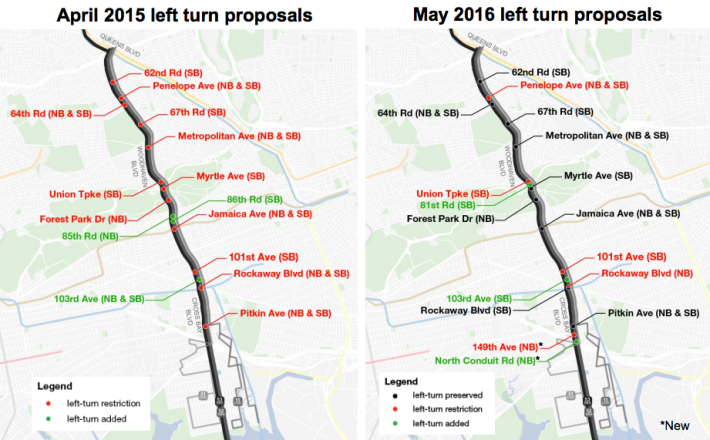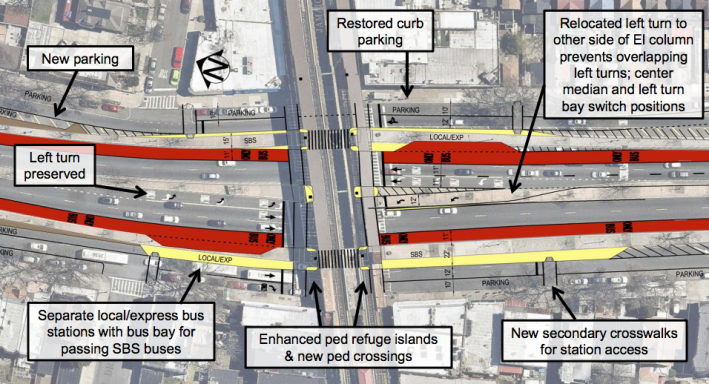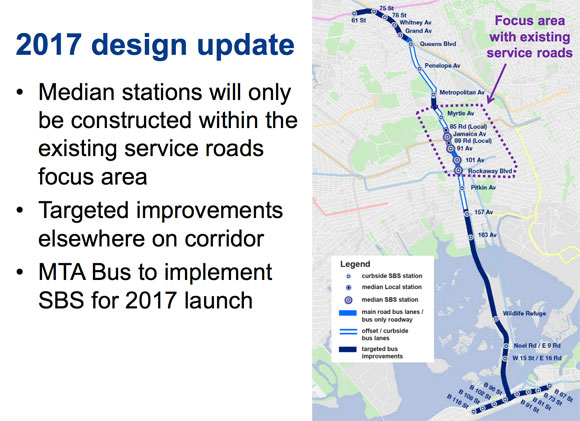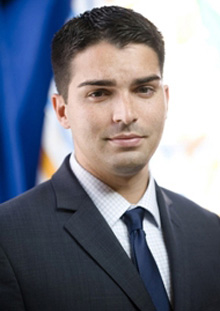
DOT has halved the number of left-turn restrictions and cut about a mile of bus lanes from its plan to enhance bus service on Woodhaven Boulevard.
The changes will dampen the expected improvements in bus speeds and pedestrian safety but have won over Council Member Eric Ulrich, who's back on board supporting Woodhaven Select Bus Service. Most of the street design, which will add dedicated bus lanes and pedestrian islands along Woodhaven and Cross Bay Boulevards, remains unchanged since the last iteration of the project, and DOT says the effects will be small.
In January, Ulrich told a meeting of the Woodhaven Residents' Block Association -- which organized against the plan -- that DOT's proposal "stinks." Chief among Ulrich's concerns was a proposed left-turn ban at Jamaica Avenue. "I don't think it's good," he said of the plan. "I think we have to go back to the drawing board."
It was a disappointing change of stance from an elected official who had been one of the project's main proponents. In 2014, Ulrich co-authored an op-ed in the Daily News calling for "world-class" bus rapid transit on Woodhaven Boulevard.
Later that year, he told Streetsblog that the project was important to improve safety on Woodhaven, where more people lost their lives than any other street in Queens between July 2012 and December 2014, according to Transportation Alternatives.
“Whatever we’re doing now obviously isn’t working,” Ulrich said at the time.
DOT presented the revised project last week [PDF]. In addition to the left turn at Jamaica Avenue, the updated plan preserves left turns at Pitkin Avenue, Forest Park Drive, Myrtle Avenue, Metropolitan Avenue, 67th Road, 62nd Road, and southbound at Rockaway Boulevard -- all of which were set for turn bans in the previous iteration of the plan. A section of bus lane between the Belt Parkway and Jamaica Bay has also been cut.
I tweeted at Ulrich to ask if the changes to the project meant he was back on board, to which he responded in the affirmative.
“We’re pleased to see that many of the left turns have been reinstated," Ulrich spokesperson Kevin Tschirhart told Streetsblog. "We’ve always wanted to make modifications and work collaboratively to make certain modifications to the project, but we’ve always been for SBS."
The left-turn restrictions had two purposes -- speeding up bus trips by eliminating the signal time allocated to turn phases, and reducing conflicts between turning drivers and pedestrians. Left turns cause three times as many serious pedestrian injuries and fatalities as right turns, according to DOT. In 2015, one pedestrian was killed and 20 people were injured at the Jamaica Avenue intersection, which runs under the elevated J/Z train.
Asked about the impact of the changes on bus speeds and safety, Tschirhart said, "We’re going to keep looking into that, but at the same time there are a lot of people in Queens and New York City who drive with cars, and you do have to keep their perspective in mind as well."
In place of the turn bans, "safer left turns will be achieved by re-engineering the left turn bays around subway columns to decrease blind spots and the frequent occurrence of North-South left-turn collisions," DOT said in a statement earlier this week.

Each weekday, bus riders make about 30,000 trips on the routes that will get a speed boost from Woodhaven SBS.
In an email, DOT said it does not expect the changes to significantly detract from the effectiveness of the project:
Restricting left turns is something that NYC DOT does carefully, since there are tradeoffs between improving through travel for bus passengers and general traffic and providing important local access for people in cars and goods delivery in trucks. Some of the left turns were also originally proposed to be restricted to ameliorate a safety issue, which in many cases we have been able to address through other improved roadway geometry, such as pedestrian refuges, re-aligned turn bays, and additional crosswalks. We believe that the net effect on bus travel by continuing to allow left turns at these locations is small, and is more than balanced out by the substantial new bus lanes, signal priority, and fare collection improvements also planned as part of the Woodhaven SBS project.
The first phase of the project, scheduled for implementation next year, calls for about five miles of bus lanes, including 1.3 miles running in the central roadway, next to existing pedestrian medians. The rest of the bus lanes will run next to the curb or the parking lane, where there's more potential for conflicts with cars. Off-board fare collection and signal priority for buses will be in effect on the whole corridor.

An earlier version of the project called for six miles of bus lanes, including four miles of median bus lanes. That configuration might still be built as part of a second phase, but last year the city pushed the construction timeline for phase two indefinitely into the future.
DOT is hosting three public workshops in the coming weeks on the proposal: May 17 in the Rockaways, May 21 in Ozone Park, and May 25 in Woodhaven. Design will be finalized over the summer, and construction will begin in the fall -- with SBS scheduled to begin operating in 2017. At some point that will be followed by a second phase that includes the full reconstruction of Woodhaven Boulevard and, potentially, more median bus lanes.






